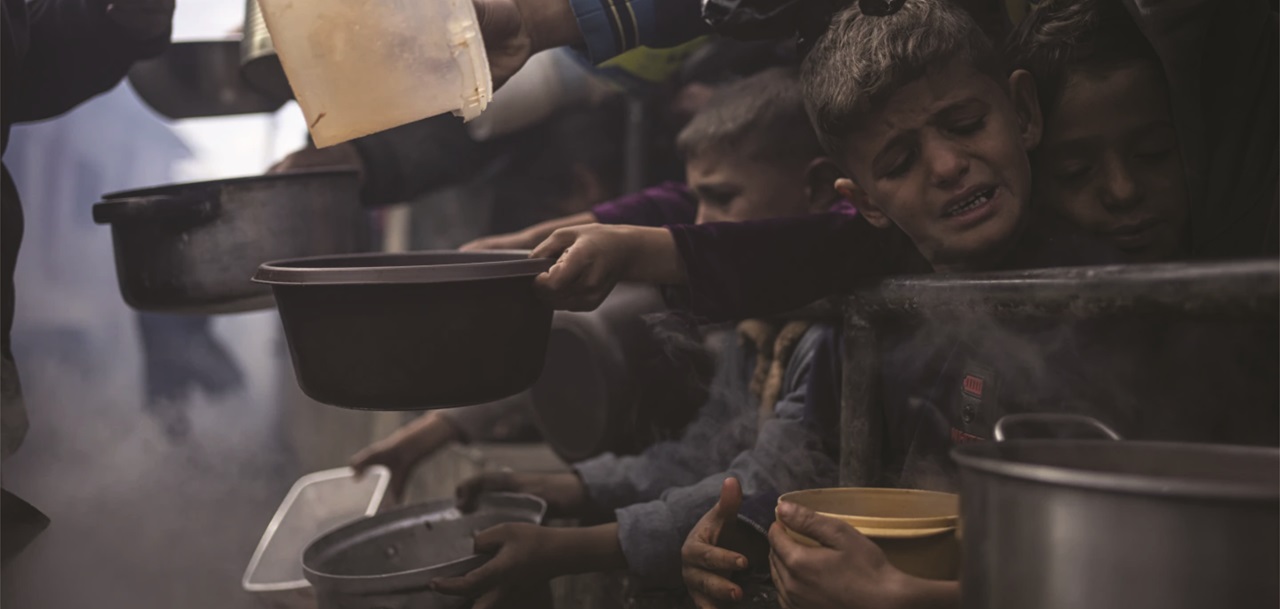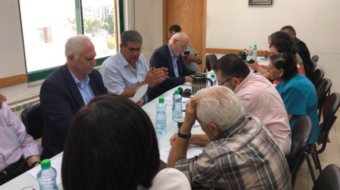
According to reports Monday morning, negotiations are moving—slowly, painfully—toward another temporary ceasefire in Gaza to allow for prisoner exchanges between Israel and Hamas. But before any halt in the destruction can be finalized, the Israeli Defense Forces is intensifying the terror of its assault on Gaza and solidifying its hold on Palestinian territories.
“The Israeli government is starving Gaza’s 2.3 million Palestinians,” Omar Shakir of Human Rights Watch, charged Monday. Shakir is the Israel and Palestine Director for HRW. Referring to the International Court of Justice’s order that Israel provide aid to Gaza, Shakir said, “The Israeli government has simply ignored the court’s ruling, and in some ways even intensified its repression, including further blocking lifesaving aid.”
That includes shooting up food convoys and blockading shipments. Late last week, CNN reported that Israeli forces fired on United Nations food trucks at an IDF checkpoint on Feb. 5 and prevented the aid from entering Gaza. The convoy’s contents were mostly wheat flour used for baking bread; it was completely destroyed.

Though Gazans have been telling the world for months that Israel was forcing them into famine, to have the mainstream U.S. corporate media confirm it signals the increasing undeniability of the IDF’s horrors.
Contrary to all obvious evidence, Israel claims it is not stopping the entry of aid and blames international humanitarian organizations for not bringing food into Gaza. The United Nations says that’s a lie; it accuses Israel of strangling Gaza by sealing almost every single border crossing and making it impossible for aid workers to do their job.
The U.N.’s World Food Program was forced last week to pause shipments into northern Gaza because Israeli forces wouldn’t stop attacking them. Over 130 U.N. staff have been killed during the war so far.
In December—two months ago—the agency said that over 500,000 people, a quarter of Gaza’s population, were already starving. The scale of the famine at the time was judged to be worse than Afghanistan and Yemen.
Since then, the situation has only deteriorated further. A report released by the Global Nutrition Cluster, an aid partnership led by UNICEF, found that in 95% of Gaza’s households, adults aren’t eating in order to ensure small children have food. At least 65% of families eat only one meal a day.
More than 90% of children younger than 5 in Gaza eat two or fewer food groups a day, known as severe food poverty, the report said. A similar percentage are infected with disease, with 70% experiencing diarrhea in the last two weeks. More than 80% of the few homes left standing lack clean running water.
“You find that there are people who have missed meals for a day or two days or three days—they have severe hunger,” Matthew Hollingworth, country director for WFP, said on Wednesday. “But you also have people who have acute hunger, that is, they are not eating for a week.”
“It doesn’t get any worse,” Arif Husain, the WFP’s chief economist said. “I have never seen something at the scale that is happening in Gaza. And at this speed.”
When the war started in October, Israel shut down all deliveries of food, water, medicine, and food into Gaza, launching the forced starvation of the territory’s 2.3 million residents. Before Oct. 7, over 500 aid trucks a day kept Gaza alive; currently, an average of 57 trucks are entering the territory daily.
Even the handful of shipments that make it through are often stopped by protesting Israeli settlers who block roads while the IDF does nothing to intervene.
Word from Gazans on the ground testify to the genocidal conditions Israel has forced on them.
“The situation is beyond your imagination,” Soad Abu Hussein, a widow and mother of five children sheltering at Jabaliya refugee camp, told the Associated Press.
Ayman Abu Awad, who lives in Zaytoun, said he eats one meal a day to save whatever he can for his four children. “People have eaten whatever they find, including animal feed and rotten bread,” he said.
The U.N. argues its reports are not warnings of what could happen but rather descriptions of what’s occurring now.
“People are already dying from hunger-related causes,” the WFP stated. UNICEF officials said that Gaza “is poised to witness an explosion” in child deaths from starvation—on top of the thousands already killed by Israeli bombardment.

Meanwhile, as Gaza slips into a manmade famine, the Israeli government is steaming ahead with its plan to launch a massive ground attack on Rafah, Gaza’s southernmost town on the Egyptian border. More than 1.4 million Palestinians have fled there in an attempt to escape Israeli forces. Pressed up against the frontier, they have nowhere left to go.
Despite talk of a supposed ceasefire and U.S. requests to hold off on further offensives, the Netanyahu War Cabinet announced Monday that the army had finalized its plans for the attack Rafah.
The Biden administration continues to tell the media that it “does not support” Israel’s scheme to obliterate Gaza, and spokespersons have said the president “is frustrated” by Netanyahu’s refusal to cooperate with humanitarian organizations.
However, the supposed “frustration” Biden feels has not yet led him to stop putting weapons into Netanyahu’s hands. Late last week, the Wall Street Journal reported that over 1,000 new MK-82 bombs and thousands of bomb components from the U.S. are on the way to Israel.
The U.S. also vetoed yet another U.N. Security Council resolution last week demanding an immediate ceasefire in Gaza.
Add it all up, and it becomes obvious that official U.S. support for Israel’s actions remains unchanged—proving again the need for a dedicated political fight by the ceasefire movement in the U.S. to up the pressure on the White House and Congress.
For the people of Gaza, a real ceasefire cannot come soon enough.
“I wish death for the children because I cannot get them bread. I cannot feed them. I cannot feed my own children,” Naim Abouseido yelled in anguish to an AP reporter as he waited for aid in Gaza City a few days ago. “What did we do to deserve this?”
We hope you appreciated this article. At People’s World, we believe news and information should be free and accessible to all, but we need your help. Our journalism is free of corporate influence and paywalls because we are totally reader-supported. Only you, our readers and supporters, make this possible. If you enjoy reading People’s World and the stories we bring you, please support our work by donating or becoming a monthly sustainer today. Thank you!












Comments